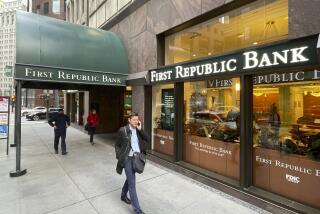Who’s Right in Controversy Over Glenfed?
- Share via
OK, here’s the deal. We can pay maybe $700 million now, or we can pay $4 billion later. Sounds like an easy choice, right?
Glendale Federal Bank says that’s about the extent of our options regarding the ailing thrift. Either inject some of the taxpayer money that Glenfed says it is due or watch it turn into the costliest thrift bailout in history.
Fortunately, those aren’t the only alternatives, as much as Glendale Federal would like you to believe otherwise. Unfortunately, Glenfed looks as if it’s entitled to that which it seeks, and therein lies a tale.
What’s happened to Glendale Federal is worth noting not just because it is the nation’s fifth-biggest thrift and a major Southern California financial institution, but because it also offers a glimpse at how even some of the strongest thrifts were brought low by changing times, changing laws and the decisions of their own managements.
Here’s the situation. Once a solid performer, Glenfed is now undercapitalized, largely, it contends, as a result of a change in federal regulations requiring the rapid write-down of the phantom capital known as “goodwill.”
Many thrifts have found their lives made uncomfortable by this requirement, which arose from the savings & loan disaster of the 1980s. To a financial institution, capital is the money that investors have sunk into the place, and it is the only real cushion against losses.
You probably have a little capital too: money in the bank, securities, a car, maybe a house. You also might have a good reputation, but you can’t say for sure it’s worth anything. Thrifts, on the other hand, have been banking on their good name and other intangibles for some time, in a category of capital known as “goodwill.”
The most important thing to remember about goodwill is that it doesn’t exist.
Anyway, back in 1981, Glendale Federal acquired First Federal Savings & Loan of Broward County, Florida. First Federal was basically insolvent; liabilities were estimated to exceed assets by $735 million. But Glendale Federal wanted its Florida branch system, and the government wanted not to have to lay out $735 million to uphold its deposit guarantee.
The results were classic thrift-era hocus-pocus. Glendale Federal acquired First Federal simply by agreeing to take on its debts; Glenfed also got to add $735 million to its capital in the form of “goodwill.”
In other words, presto: Uncle Sam passed a magic wand, and a $735-million liability was suddenly offset by a $735-million asset. All Glendale Federal had to do was write most of it down over the next 40 years, as if it were a factory and had a useful life.
During the 1980s, Glenfed engaged in some of the risky practices embraced by many of its thrift-industry brethren, but it avoided junk bonds and other activities now considered suicidal for a savings and loan.
In 1989, though, a new federal law basically wiped out the use of goodwill by thrift institutions. The trouble, from Glenfed’s point of view, was that it had a deal. It never would have taken on First Federal without the magic of goodwill, which was sort of a way for the government to print money without ink.
As a result partly of the S&L; mess, the Southern California real estate market went bad just as the government imposed its new requirements, which helped make things worse by constricting lending and exacerbating the property sell-off.
Glenfed, for example, frantically began paring itself back to get its assets in line with its real capital. Despite these efforts, it finds itself short of the capital mark and facing a potential government takeover.
Its shareholders’ investment dwindling, Glenfed took its case to the U.S. Court of Federal Claims, where a judge has already found for Glenfed. (The government, claiming that there was no contract, has appealed.) Today, perhaps as you read this, Glenfed will argue at a claims court hearing in Washington that the thrift was so badly wronged by the government that it’s entitled to damages approaching $1.4 billion.
Who’s right? As much as I hate to side with a savings and loan, the answer is Glendale Federal, and not because the alternative to paying now is paying more later. Liquidating Glenfed, after all, would be idiotic.
Glenfed Chief Executive Stephen J. Trafton bases the $4-billion bailout estimate on the assumption that Glenfed’s assets would deteriorate by that amount if the government had to dispose of them. But he also says Glenfed has at least $500 million in capital, which implies that some other thrift would want it, perhaps with a little federal cash. So all this $4-billion bailout talk is a scare tactic.
On the other hand, some observers figure that the government shouldn’t pay because the woods are full of people harmed by the end of goodwill. Imagine if they all came forward and demanded restitution.
Well, whose problem is that? Not Glenfed’s. Do we reject the claim of an asbestos worker because a slew of others were injured as well? This argument is as bad as Glenfed’s “pay or else.”
But of course, a precedent might indeed be set. So the best way out, in my view, would be for Uncle Sam to settle out of court by injecting some cash--Glenfed would be delighted to get away with $700 million--in exchange for convertible preferred stock. Remember Chrysler? The taxpayers made money on those warrants, and that bailout was voluntary.
This one is really much simpler. Glenfed’s predicament--and the government’s--has nothing to do with whether the thrift industry was run by angels or whether paying Glenfed will inspire others to come forward (some already have) or anything else except a concept familiar even to schoolchildren: A deal is a deal.
More to Read
Inside the business of entertainment
The Wide Shot brings you news, analysis and insights on everything from streaming wars to production — and what it all means for the future.
You may occasionally receive promotional content from the Los Angeles Times.










